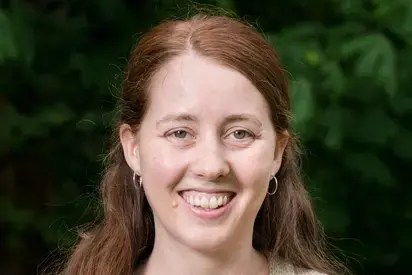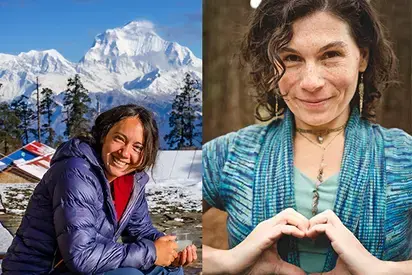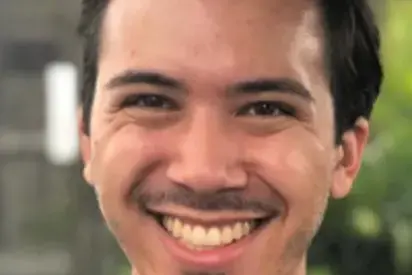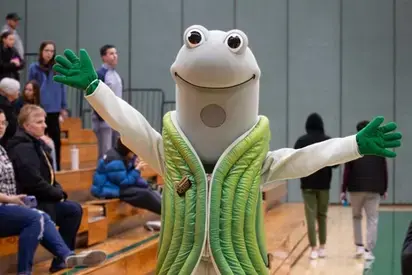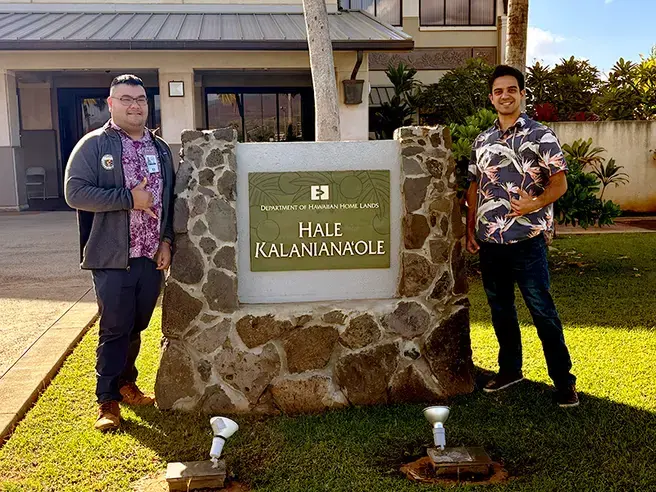
We invite you to join us as we sit down with Hawaiian Home Lands Broadband team members, friends, and advocates Jaren Tengan ’16, and Keith V. Adams IV ’17, to learn more about their journeys at Evergreen and work bringing broadband equity to Native Hawaiians. Alumni Programs is denoted as AP, Jaren Tengan is denoted as JT, and Keith V. Adams IV is denoted as KA in this interview.
AP: Tell us about yourselves, who is Keith Adams and Jaren Tengan, and how do you know each other?
KA: I am just a regular Oahu boy born and raised. Serendipitously Jaren and I found each other at Evergreen and in our professional lives as well. I went to Evergreen in 2013 and my focus was in forest ecology, so not related to Broadband at all, but throughout the years I gained more experience in grant writing and administration which is what brought me to the current work I am doing with Jaren. It’s also super cool to change careers and change what you are doing, I’m not afraid to do that.
JT: I’m Jaren, born and raised in Oahu, met Keith at Evergreen, and started in 2012. We grew up on different sides of the island and were always a few connections away but not in each other's lives until we met at Evergreen. I remember meeting Keith by the soccer fields, he came up to me and was like ‘dude are you from Hawaii?’ and from there we became good friends. I graduated from Evergreen with a focus in political economy, so most programs I took were policy or economics focused. I did take some courses on Native American Affairs with Arwen Spites, and I am really excited to be here and sharing my story. Evergreen had a profound impact on my life, who I am today, how I approach problems and solve them.
AP: What brought you to Evergreen?
KA: I have to give it up to my College Counselor Judy Watanabe who is the person who got me to Evergreen. I somehow ended up with 2 free periods in my senior year of high school. So, I took those periods to pass out mail for different departments, this lady, Judy, didn't hold any punches and told me how lazy I was and challenged me to do more with my life instead of just getting by. So, she had encouraged me to apply for Evergreen, the only school I applied for. I got accepted and received a scholarship, and that was it, I went.
JT: I had a teacher in high school, Kapono Ciotti ’99, who is an Evergreen alum, he had a unique way of keeping his students engaged and excited to learn That was profound for me. I was originally going to join the navy, but my parents wanted me to apply to college, so I applied to two schools, one of them was Evergreen I got into both schools, and was like what do I do? My parents told me to try out Evergreen. I went in 2012 and really liked it. I wasn't the best student in high school, so Evergreen gave me a huge chance, it was something that I needed.
KA: Thats the thing about Evergreen, they gave us a chance. I didn't really go to school throughout high school and Evergreen gave me a chance, gave Jaren a chance. The culture of Evergreen and the culture of learning there is what brought us out, it brought our real selves out, including who we were going to be in college, as professionals, and who we were striving to become.
AP: Were there any classes or faculty that inspired you while at Evergreen?
JT: Yes, one of them was Ralph Murphy, he really helped me understand the government process. Evergreen is a very unique school where the community learning allows you to work and talk to people of different backgrounds and views. Arlan Spites taught me Native American Policy, he let me run with some ideas and dig deep into Native American Law that has effects on us even here at the Department of Hawaiian Home Lands. It was an interesting experience, and I am thankful for those professors. There’s also Tom Womeldorff and Kenneth Tabbutt who taught River Resources, an economist and geologist, they were great because they saw potential in me and how to apply myself, studying, and getting work done. It helped me become who I am today. These professors have given me the tools to solve multipronged problem sets that I have faced in my professional Career.
KA: It’s funny Ralph Murphy was a teacher who had a lasting impact on my life too. Because he was another person who didn't pull any punches, said things to you straight, called you out on BS, and held you accountable. But like Jaren was saying about another teacher of his, it put into perspective that I needed to step it up. The first year of college you want to have fun but when someone calls you to step up you need to answer those calls, Ralph was that person for me. Dylan Fisher is another professor who I spent most of my college career with in classes learning how to be a scientist. But he was always super passionate in his lectures and everything he did, and that passion was infectious.
Another person is Erik Thuesen who is a passionate, super cool teacher I had. Erik and Dylan showed me the importance of being a self-starter and stoking the fire within yourself to get things done. A lot of what we did was based on getting up, collecting the data (mostly outside), going to the library, and working on statistical analysis and reporting until like 12 a.m. when the library closed. There are so many faculty that inspired me, but those three impacted me the most. Erik also sponsored an internship, and that was cool, to be trusted like that, independent and represent myself and the college in the world.
AP: Can you tell us more about your work with the Department of Hawaiian Home Lands Tribal Broadband Connectivity Program?
JT: Keith and I oversee the broadband program which was set up to apply and administer funds set aside for Native Hawaiians by the National Telecommunication and Information Agency through the Tribal Broadband Connectivity Program. Our task is to rebuild and expand the broadband infrastructure network on Hawaiian Home Lands. We are unique because we are not a federally recognized tribe, but we are eligible for funding opportunities as an entity. We have about 200,000 acres, roughly the size of Austin, Texas, that the department owns. However, not all that acreage is suitable for homesteading; it mainly consists of forests and open areas. The department was set up through the enactment of the Hawaiian Homes Commission Act of 1920 (HHCA) and we are entrusted with the administration of that act and the proliferation of Trust.
AP: Did the fires in Lahaina affect any Home Lands?
JT: That was a crazy situation, but thankfully the Home Lands that are just outside of Lahaina, Leialii, were spared. Interestingly, if you look at the burn maps, the fire went around the community. Unfortunately, this was not the case everywhere and our hearts go out to those people and families impacted.
This event has really laid bare the importance of building resilient infrastructure. Since the infrastructure within Leialii was built underground, they were able to bounce back, so to speak, a lot faster than other places with aboveground utilities.
Additionally, this has helped those who aren’t sensitive to climate change understand how dire our situation is and the importance of addressing this future that we all share.
KA: One of our focuses is that the program funds go to rural communities who are not well connected to broadband services. A lot of these things were exacerbated by the pandemic and brought to light. Thankfully, the federal government has been putting a lot of federal dollars towards expanding dependable coverage not only in the typical urban and suburban areas but in rural areas that haven't received federal spending.
Through the Tribal Broadband Connectivity Program, we have been awarded $17 million dollars to implement projects to improve digital equity and inclusion, literacy and adoption in Native Hawaiian populations across the State. The $17 million dollars represents our first round of funding, some project highlights are that we are distributing >2,500 Macintosh laptops and 27 Smartboards to Hawaiian Charter Schools, expanding digital equity and access through the Public Library System, and improving telehealth, especially maternal telehealth, capacity across the State.
We are in the process of applying for another round of funding, $72 million, to upgrade our broadband infrastructure across Hawaiian Home Lands.
AP: What does Equity mean to you?
KA: We were discussing this earlier at work, equity is made up by various subcategories, things that support what equity is. Financial, socioeconomic, health, legal, etc. It’s very nuanced. For me it’s about fairness, morality, and justice.
JT: It’s affordability, accessibility, and understanding. That’s what we look at on our end because we have to consider equity when we do our work in these areas.
Thats the point of this work, to make up for the inequities. Our main priority is to bring access to communities and bring equity to our Hawaiian Home Lands, because we are mandated to support these communities, our purpose is to help and support.
AP: What challenges have you had to overcome in providing broadband to communities across the Hawaiian Islands?
JT: The challenge is bringing broadband to the islands, even though we are one state, the islands are unique, the people unique, and the needs are unique. We can't have a cookie cutter solution for the islands, it wouldn't be doing our beneficiaries justice. Another issue we are having to face is navigating the federal government funds, there are layered funds everywhere, it is challenging to parse what are funds the state have vs. the federal government. That’s why we went to Evergreen, there will always be issues but it's how you approach the issues and work to solve them. We are able to continue to meet our deadlines and make an impact on our Hawaiian Home Lands through our resilience and education.
KA: The complexities of federal and state grants systems and of our communities are the challenge. Also, we are an island in the middle of the sea, so all these things need to be shipped to us before we can even begin deploying. Every day there are new surprises, no unexciting or dull moments.
AP: Who opened doors for you?
KA: My buddy Jaren! He’s always been on the lookout for me. I think when at Evergreen you are able to really connect with people who have stuck with you for four or five years and we found those lasting friendships of people who support us.
JT: Evergreen opened doors for us, they gave us a chance and we were lucky enough to have those mentors who believed in us and who pushed us to do more. Even though Keith and I’s paths are different, we came back, because we needed these skillsets to complete this monumental task. The collaborative nature of Evergreen and academic structure puts it on you, you are going to make or break your academic career. That opened the door for us. When I applied for jobs and interviews, I was able to stand out because we can critically think about problems and solutions.
AP: What impact do you hope to make through your work?
JT: I think Keith would agree with this: We know this is going to lift up the native Hawaiian people. That is the key for Hawaii to rejuvenate itself and be a 21st century state. When we lift this population up, the impact it will have is that we can bring people back to Hawaii. Those who moved away for high paying jobs that need internet have left their communities behind to make ends meet, the native Hawaiian people, they do fall under the disparaged populations. By closing that gap though, we can lift them up and in turn the whole state.
KA: I will second what Jaren said. It starts with equity and supporting Hawaiian people. It’s a big part of what will lift the state up, from our perspective.
AP: What advice would you give current students studying at Evergreen today who will join you as alumni?
KA: Push yourself. You cannot wait for things to happen. Like Jaren said earlier, Evergreen is the school that puts it on your shoulder.
If you want an education that you sit back and skate by, it's not Evergreen. And some people find that out the hard way. We lost some friends who had different goals for their education, or the Evergreen way didn't jive with them personally, but you have to step up into your personal responsibility and grow. Also get outside, use that beautiful forest. It saved me personally, especially in the darker months. Every moment that Jaren and I didn't put towards school we were in the forest rain or shine enjoying the beautiful campus, we would get lost, collecting scientific data, foraging for mushrooms, and soaking in the beauty.
JT: I agree with Keith. Staying motivated and going forward. Also remain flexible and be human, there are times when people won't agree with you after college. But that's why we have seminars and collaborative learning sessions because you can get things done. Also, do the right thing, but you must be willing to talk and collaborate with people. There are no wrong answers, it's what is in the best interest of your work or beneficiaries.
AP: What is your superpower?
KA: Mine would be don’t be afraid to try new things. Thats the name of the game for me right now, I just can’t be afraid to risk it all.
JT: Slow down time. There is not enough time in the day to do what I want.

